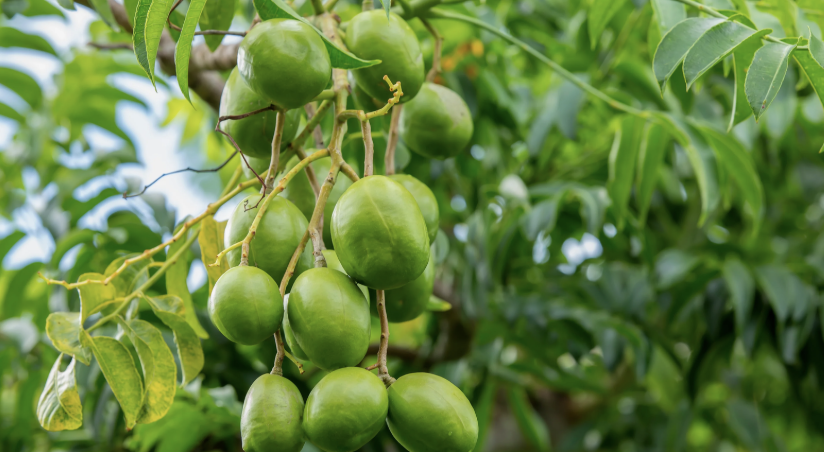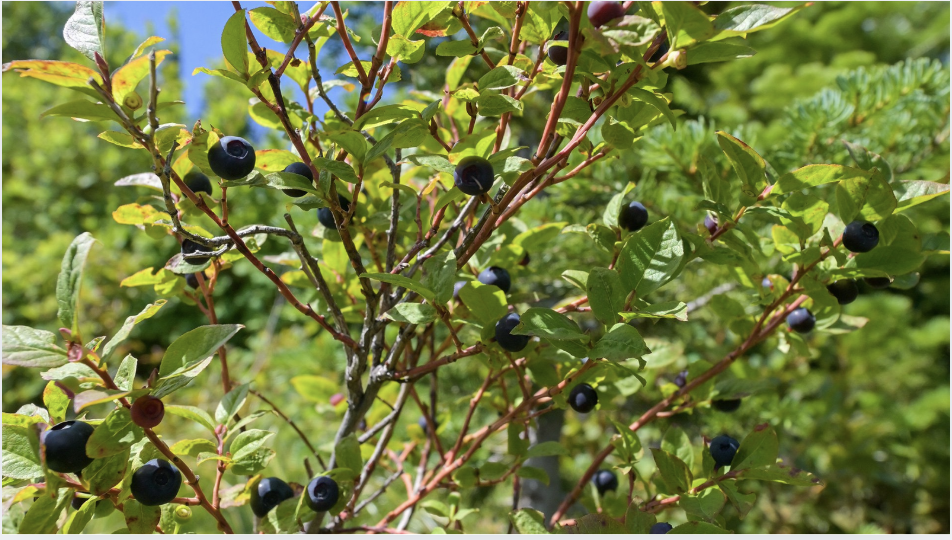17+ Fruits that Start with H with Facts and Pictures

Exploring new fruits can be tough. However, you might feel stuck with the same old apples and bananas, unsure what else to try. I get it – I’ve been there too.
But don’t worry! I’m here to expand your fruit knowledge with exciting options you might not have considered. In this post, I’ll introduce you to over 17+ tasty fruits that start with the letter H.
From familiar favorites to exotic treats, you’ll find a variety of flavors and textures to liven up your diet.
Get ready to discover new fruits that could become your next go-to snack or recipe ingredient.
Fruits that Start with H
From familiar fruits to exotic options like Hackberry to Haws, these fruits showcase nature’s variety.
The collection introduces 17+ H-fruits with unique characteristics, origins, and health benefits.
1. Hala Fruit

Hala Fruit is a large, round fruit with a distinctive appearance. It features a cluster of segments that resemble a spiky ball. The fruit has sweet, fibrous flesh.
The fruit is often used in traditional Polynesian and Micronesian cuisine. Its leaves are also used to weave mats and make handicrafts.
Place of Origin: Pacific Islands
Scientific Name: Pandanus tectorius
Famous Alternative Names: Pandanus Fruit, Screwpine Fruit
Nutritional Content per 100 grams:
| Calories | 74 |
|---|---|
| Fat | 0.2 g |
| Carbohydrates | 18 g |
| Protein | 0.8 g |
| Fiber | 3 g |
Health Benefits:
- It is highly rich in antioxidants like Beta-carotene, and Vitamin C
- Usually, it supports eye health and may reduce the risk of macular degeneration
- Promotes digestive health due to high fiber content
- It contains anti-inflammatory properties that may help reduce pain and swelling
2. Hackberry

Hackberry is a small, sweet fruit with a crunchy seed inside. It is often eaten fresh or dried.
These berries have been used by Native Americans as a food source for centuries. The tree is also valued for its hardy wood and ornamental use in landscaping.
Place of Origin: North America
Scientific Name: Celtis occidentalis
Famous Alternative Names: Sugarberry, Nettletree
Nutritional Content per 100 grams:
| Calories | 100 |
|---|---|
| Fat | 1 g |
| Carbohydrates | 25 g |
| Protein | 1 g |
| Fiber | 6 g |
Health Benefits:
- Antioxidants like Flavonoids, and Polyphenols
- Supports immune health by providing essential vitamins and minerals
- Promotes digestive health with its fiber content
- It may help reduce oxidative stress
3. Hardy Kiwi

Hardy Kiwi is a small, smooth-skinned fruit with a sweet, tangy flavor. It is often eaten fresh or used in desserts.
Unlike the common kiwi, the Hardy Kiwi does not require peeling. This fruit is known for its cold hardiness, making it suitable for growing in temperate climates.
Place of Origin: East Asia
Scientific Name: Actinidia arguta
Famous Alternative Names: Baby Kiwi, Kiwi Berry
Nutritional Content per 100 grams:
| Calories | 61 |
|---|---|
| Fat | 0.8 g |
| Carbohydrates | 15 g |
| Protein | 1.2 g |
| Fiber | 3 g |
Health Benefits:
- Highly rich in Vitamin C, Polyphenols
- Supports immune function and helps fight infections
- Promotes digestive health and prevents constipation
- It may improve skin health by promoting collagen production
4. Haws (Hawthorn Berries)

Haws, or Hawthorn Berries, are small, red fruits with a tart flavor. They are often used in traditional medicine and as dietary supplements.
Hawthorn berries are known for their cardiovascular benefits. They are also used in herbal teas and tinctures to promote heart health.
Place of Origin: Europe, Asia, North America
Scientific Name: Crataegus
Famous Alternative Names: Mayhaw, Quickthorn
Nutritional Content per 100 grams:
| Calories | 52 |
|---|---|
| Fat | 0.3 g |
| Carbohydrates | 12 g |
| Protein | 0.9 g |
| Fiber | 2.7 g |
Health Benefits:
- Antioxidants like Flavonoids, and Procyanidins are found in this
- Supports cardiovascular health by improving blood flow and reducing blood pressure
- It greatly promotes digestive health by aiding in the breakdown of food
- It may help reduce anxiety and stress
5. Himalayan Mulberry

Himalayan Mulberry is a small, dark purple fruit with a sweet-tart flavor. It is often eaten fresh or used in jams and desserts.
This fruit is particularly rich in iron and vitamin C. It has been used traditionally to improve blood health and circulation.
Place of Origin: Himalayas
Scientific Name: Morus macroura
Famous Alternative Names: Long Mulberry, Shahtoot
Nutritional Content per 100 grams:
| Calories | 43 |
|---|---|
| Fat | 0.4 g |
| Carbohydrates | 10 g |
| Protein | 1.4 g |
| Fiber | 1.7 g |
Health Benefits:
- Abundantly rich in antioxidants like Resveratrol, Vitamin C
- Supports heart health by reducing cholesterol levels
- Promotes healthy blood sugar levels
- It may improve digestive health
6. Honeyberry

Honeyberry is a small, blue fruit with a sweet-tart flavor. It is often eaten fresh or used in jams, jellies, and desserts.
These are one of the earliest berries to ripen in the spring. They are known for their high levels of antioxidants and vitamin C.
Place of Origin: Russia, Japan
Scientific Name: Lonicera caerulea
Famous Alternative Names: Haskap, Blue Honeysuckle
Nutritional Content per 100 grams:
| Calories | 33 |
|---|---|
| Fat | 0.2 g |
| Carbohydrates | 8.3 g |
| Protein | 0.4 g |
| Fiber | 2.3 g |
Health Benefits:
- It contains antioxidants like Anthocyanins, and vitamin C
- It also supports cardiovascular health by improving blood vessel function
- Promotes digestive health by aiding in regular bowel movements
- It may improve immune function
7. Honeycrisp Apple

The Honeycrisp Apple is a popular variety known for its crisp texture and sweet-tart flavor. It is often eaten fresh or used in salads and desserts.
The University of Minnesota developed this apple variety. It is praised for its long shelf life and juiciness.
Place of Origin: United States
Scientific Name: Malus domestica
Famous Alternative Names: Honeycrunch Apple
Nutritional Content per 100 grams:
| Calories | 52 |
|---|---|
| Fat | 0.2 g |
| Carbohydrates | 14 g |
| Protein | 0.3 g |
| Fiber | 2.4 g |
Health Benefits:
- Highly rich in Quercetin, Catechin which are great antioxidants
- Supports heart health by reducing cholesterol levels
- It also promotes digestive health and prevents constipation
- It may help regulate blood sugar levels
8. Honeydew Melon

Honeydew Melon is a sweet, juicy fruit with a smooth, pale green rind and green flesh. It is often eaten fresh or used in fruit salads and desserts.
Honeydew melons are known for their hydrating properties. They are also low in calories, making them a great snack for weight management.
Place of Origin: West Africa
Scientific Name: Cucumis melo
Famous Alternative Names: Bailan Melon, White Antibes
Nutritional Content per 100 grams:
| Calories | 36 |
|---|---|
| Fat | 0.1 g |
| Carbohydrates | 9 g |
| Protein | 0.5 g |
| Fiber | 0.8 g |
Health Benefits:
- It contains antioxidants like Vitamin C and Beta-carotene
- Supports immune function and helps fight infections
- Promotes hydration due to high water content
- It greatly improves skin health
9. Horned Melon (Kiwano)

Horned Melon, also known as Kiwano, is an exotic fruit with a spiky orange rind and lime-green, jelly-like flesh. It has a tart, cucumber-like flavor.
The fruit is often used as a garnish or in exotic fruit salads. It is also valued for its high water content, making it very hydrating.
Place of Origin: Sub-Saharan Africa
Scientific Name: Cucumis metuliferus
Famous Alternative Names: African Horned Cucumber, Jelly Melon
Nutritional Content per 100 grams:
| Calories | 44 |
|---|---|
| Fat | 1.3 g |
| Carbohydrates | 8 g |
| Protein | 1.8 g |
| Fiber | 3.7 g |
Health Benefits:
- It carries antioxidants like Beta-carotene and Alpha-tocopherol
- Supports eye health and may reduce the risk of macular degeneration
- It promotes skin health by providing essential vitamins
- It also boosts the immune function
10. Hyuganatsu

Hyuganatsu is a citrus fruit with a sweet, slightly tart flavor, native to Japan. It is often eaten fresh or used in desserts and juices.
Hyuganatsu is traditionally eaten with a sprinkle of sugar to enhance its flavor. It is also used in making marmalades and candied peels.
Place of Origin: Japan
Scientific Name: Citrus tamurana
Famous Alternative Names: New Summer Orange
Nutritional Content per 100 grams:
| Calories | 38 |
|---|---|
| Fat | 0.2 g |
| Carbohydrates | 9.6 g |
| Protein | 0.6 g |
| Fiber | 2.4 g |
Health Benefits:
- It also contains Vitamin C and Flavonoids
- It also supports immune health and helps fight infections
- Greatly promotes digestive health and reduces bloating
- It also helps in improving skin health
11. Hog Plum

Hog Plum is a small, tart fruit with a yellow to orange color, often used in pickles, sauces, and traditional medicines.
It is commonly used in Central and South American cuisines. Hog Plum is also known for its potential to improve digestion and boost metabolism.
Place of Origin: Central and South America
Scientific Name: Spondias mombin
Famous Alternative Names: Yellow Mombin, Spanish Plum
Nutritional Content per 100 grams:
| Calories | 46 |
|---|---|
| Fat | 0.5 g |
| Carbohydrates | 11 g |
| Protein | 0.5 g |
| Fiber | 2.2 g |
Health Benefits:
- Highly rich in Vitamin C, Flavonoids
- It supports immune health and helps protect against infections
- Promotes digestive health and aids in regular bowel movements
- It carries amazing anti-inflammatory properties
12. Huckleberry

Huckleberry is a small, round berry with a sweet-tart flavor, often used in jams, pies, and desserts.
Huckleberries are highly valued in the Pacific Northwest and are often foraged in the wild. They are celebrated for their unique taste and high antioxidant levels.
Place of Origin: North America
Scientific Name: Vaccinium spp.
Famous Alternative Names: Whortleberry, Bilberry
Nutritional Content per 100 grams:
| Calories | 37 |
|---|---|
| Fat | 0.1 g |
| Carbohydrates | 9.6 g |
| Protein | 0.7 g |
| Fiber | 2.5 g |
Health Benefits:
- It contains Anthocyanins, and Vitamin C which are very important antioxidants
- Supports cardiovascular health by reducing cholesterol levels
- It also promotes digestive health by aiding in regular bowel movements
- It greatly improves eye health
13. Honey Globe Melon

Honey Globe Melon is a large, round melon with smooth, green skin and sweet, juicy flesh. It is often eaten fresh or used in fruit salads.
This melon is prized for its exceptionally sweet flavor and high sugar content. It is often served as a refreshing dessert.
Place of Origin: China
Scientific Name: Cucumis melo
Famous Alternative Names: Honeydew Melon, Bailan Melon
Nutritional Content per 100 grams:
| Calories | 36 |
|---|---|
| Fat | 0.1 g |
| Carbohydrates | 9 g |
| Protein | 0.5 g |
| Fiber | 0.8 g |
Health Benefits:
- Contains Vitamin C, Beta-carotene
- Supports immune function and helps fight infections
- Promotes hydration due to high water content
- It may improve skin health
14. Huito Fruit

Huito Fruit is a tropical fruit with dark blue to black skin and sweet, juicy flesh. It is often used in beverages, desserts, and traditional medicines.
In some cultures, the juice of Huito Fruit is used as a natural dye. It is also believed to have various medicinal properties.
Place of Origin: Central and South America
Scientific Name: Genipa americana
Famous Alternative Names: Genipap, Jagua
Nutritional Content per 100 grams:
| Calories | 60 |
|---|---|
| Fat | 0.5 g |
| Carbohydrates | 15 g |
| Protein | 1 g |
| Fiber | 3 g |
Health Benefits:
- Highly contains Genipin and Iridoids
- Also, it supports liver health by aiding in detoxification
- Greatly promotes digestive health with high fiber content
- It carries some major anti-inflammatory and antimicrobial properties
15. Heirloom Tomato

Heirloom Tomato is a variety of tomatoes known for its unique colors, shapes, and flavors. Unlike hybrid tomatoes, heirloom tomatoes are grown from seeds passed down through generations.
Heirloom tomatoes are cherished for their rich taste and historical significance. They come in various colors, including red, yellow, green, and purple.
Place of Origin: Various (depending on the specific heirloom variety)
Scientific Name: Solanum lycopersicum
Famous Alternative Names: Heritage Tomato
Nutritional Content per 100 grams:
| Calories | 18 |
|---|---|
| Fat | 0.2 g |
| Carbohydrates | 3.9 g |
| Protein | 0.9 g |
| Fiber | 1.2 g |
Health Benefits:
- Antioxidants like Lycopene and Beta-carotene are found in this fruit
- Supports heart health by reducing cholesterol and lowering blood pressure
- It also promotes skin health and may protect against UV damage
- Rich in vitamins C and K, which boost the immune system and support bone health
16. Hawaiian Mountain Apples

Hawaiian Mountain Apples are pear-shaped fruits with shiny red skin and crisp, juicy flesh. They have a mild, sweet flavor and are often eaten fresh or used in salads and desserts.
The fruit is also known for its hydrating properties due to its high water content. It is commonly enjoyed during the summer months in Hawaii for its refreshing taste.
Place of Origin: Southeast Asia and Pacific Islands
Scientific Name: Syzygium malaccense
Famous Alternative Names: Malay Apple, Ohi’a ‘ai, Rose Apple
Nutritional Content per 100 grams:
| Calories | 25 |
|---|---|
| Fat | 0.3 g |
| Carbohydrates | 6 g |
| Protein | 0.3 g |
| Fiber | 1 g |
Health Benefits:
- It contains Anthocyanins, and Flavonoids
- Also, it supports immune health due to high vitamin C content
- It helps in promoting hydration and digestive health with its high water content
- It also helps reduce inflammation due to its antioxidant properties
17. Hairless Rambutan

Hairless Rambutan, a variety of the more commonly known rambutan, is a tropical fruit with a smooth exterior, unlike its hairy counterpart.
The fruit has a sweet and juicy flesh, similar to lychee, and is enjoyed fresh or in desserts. This variety is easier to peel and eat compared to the regular rambutan. It is also a rich source of vitamins and minerals.
Place of Origin: Southeast Asia
Scientific Name: Nephelium lappaceum
Famous Alternative Names: Smooth Rambutan, Nephelium fruit
Nutritional Content per 100 grams:
| Calories | 68 |
|---|---|
| Fat | 0.2 g |
| Carbohydrates | 16 g |
| Protein | 0.9 g |
| Fiber | 0.9 g |
Health Benefits:
- It contains antioxidants like Vitamin C, Flavonoids
- Supports immune health by boosting the production of white blood cells
- Also, it promotes skin health and collagen production
- It contains dietary fiber that aids in digestion and prevents constipation
- It helps to improve iron absorption due to its vitamin C content
18. Hollyleaf Cherry

Hollyleaf Cherry is a small, dark red to black fruit with a sweet and slightly astringent flavor.
It grows on a shrub or small tree and is often used in jams, jellies, and traditional medicines.
Place of Origin: Southwestern United States and Mexico
Scientific Name: Prunus ilicifolia
Famous Alternative Names: Evergreen Cherry, Islay
Nutritional Content per 100 grams:
| Calories | 60 |
|---|---|
| Fat | 0.5 g |
| Carbohydrates | 14 g |
| Protein | 0.8 g |
| Fiber | 2 g |
Health Benefits:
- It contains antioxidants like Flavonoids, Vitamin C
- Supports heart health by reducing cholesterol levels
- Promotes digestive health with its fiber content
- It contains anti-inflammatory properties that may help reduce pain and swelling
- It supports immune function and helps protect against infections
Final Notes
Fruits that begin with H are fun to learn about, and they can make your meals more colorful, tasty, and exciting every single day.
You might find one that looks strange or sounds funny, but trying new fruits is a great way to explore and enjoy something different.
Some of these fruits might grow far away, while others might be waiting for you at a local store or small market nearby.
When you learn about fruits and where they come from, it helps you feel more curious and makes eating healthy a lot more fun.
So next time you are picking out food, remember the letter H and see if you can find something new to try and share.
You never know, your next favorite fruit might be one you just learned about today.






